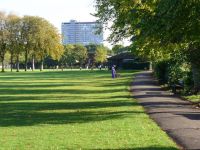Tolworth is a suburban area in the Surbiton district, Royal Borough of Kingston upon Thames, Greater London. It is 11 miles (17.7 km) southwest of Charing Cross. Neighbouring places include Long Ditton, New Malden, Kingston, Surbiton, Berrylands, Hinchley Wood, Chessington, Ewell and Worcester Park. Surbiton is the nearest, about a mile to the northwest. Tolworth is divided in two by the A3 Kingston Bypass and is situated slightly north of the Greater London-Surrey border.
History
Tolworth, in the Domesday Book, was called Taleorde. Its Domesday assets were held partly by Picot from Richard de Tonebrige and partly by Radulf (Ralph) from the Bishop of Bayeux. It rendered: 2½ hides; also 4 hides with Long Ditton; 1 mill without dues, 8 ploughs, 10½ acres and ½ rod of meadow. It rendered £6.
The Evelyn family, who had settled in Surrey, played a prominent role and established gunpowder mills at Tolworth, probably in 1561.
In 1870–72, John Marius Wilson's Imperial Gazetteer of England and Wales described Tolworth like this: "TALWORTH, a hamlet in Long Ditton parish, Surrey; 2½ miles SSE of Kingston upon Thames. Acres, 1,190. Pop., 434. Houses, 81. An ancient manor-house here was held by the Earl of Kent, uncle of Edward III.; and is now a farmhouse." For much of the 19th century the Earls of Egmont were Tolworth's principal landowners
By 1908 things were changing: the population growth was accelerating due to the development of the brickfields and the construction of Tolworth Sewage Farm (which opened in 1891), both in Red Lion Lane (now Red Lion Road). With a proper sewerage system Tolworth was ready for development. St Matthew's Church had been built for a congregation of 800 and trams now ran from the Red Lion.
In 1919 the Medical Officer of Health reported that Surbiton was a residential neighbourhood with no dominating factories or works. The only new feature of late, he said, is the springing up of a few "Motor Garages," each employing a few hands on the care and
